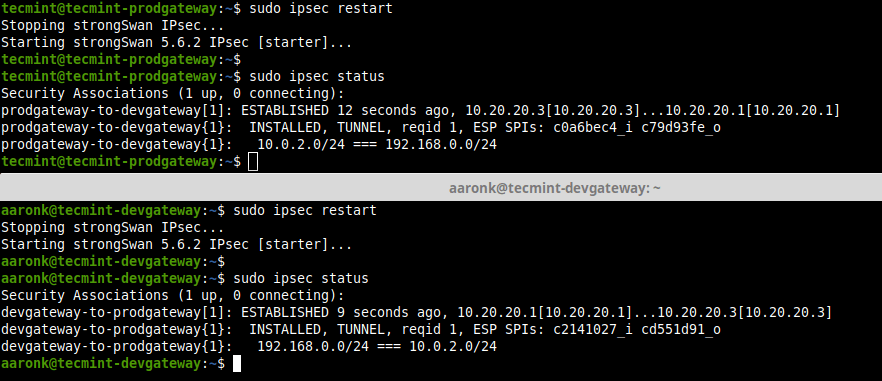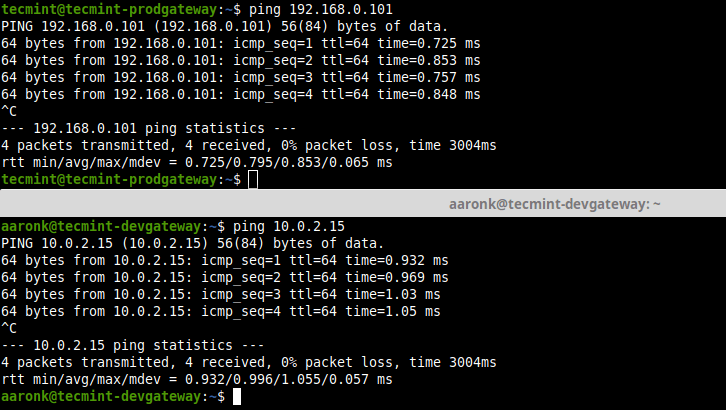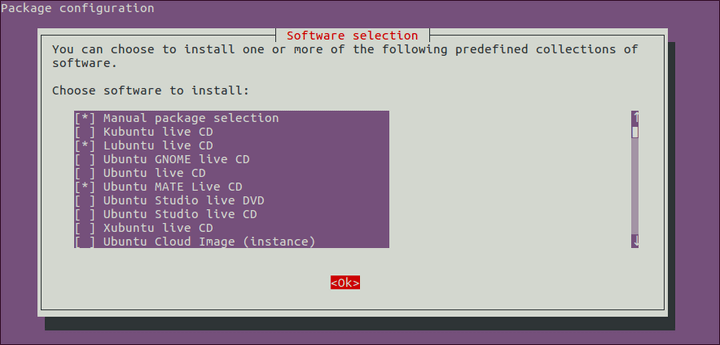strongSwan is an open-source, cross-platform, full-featured, and widely-used IPsec-based VPN (Virtual Private Network) implementation that runs on Linux, FreeBSD, OS X, Windows, Android, and iOS. It is primarily a keying daemon that supports the Internet Key Exchange protocols (IKEv1 and IKEv2) to establish security associations (SA) between two peers.
This article describes how to set up site-to-site IPSec VPN gateways using strongSwan on Ubuntu and Debian servers. By site-to-site we mean each security gateway has a sub-net behind it. Besides, the peers will authenticate each other using a pre-shared key (PSK).
Testing Environment
Remember to replace the following IPs with your real-world IPs to configure your environment.
Site 1 Gateway (tecmint-devgateway)
OS 1: Debian or Ubuntu Public IP: 10.20.20.1 Private IP: 192.168.0.101/24 Private Subnet: 192.168.0.0/24
Site 2 Gateway (tecmint-prodgateway)
OS 2: Debian or Ubuntu Public IP: 10.20.20.3 Private IP: 10.0.2.15/24 Private Subnet: 10.0.2.0/24
Step 1: Enabling Kernel Packet Forwarding
1. First, you need to configure the kernel to enable packet forwarding by adding the appropriate system variables in /etc/sysctl.conf configuration file on both security gateways.
$ sudo vim /etc/sysctl.conf
Look for the following lines and uncomment them and set their values as shown (read comments in the file for more information).
net.ipv4.ip_forward = 1 net.ipv6.conf.all.forwarding = 1 net.ipv4.conf.all.accept_redirects = 0 net.ipv4.conf.all.send_redirects = 0
2. Next, load the new settings by running the following command.
$ sudo sysctl -p

3. If you have a UFW firewall service enabled, you need to add the following rules to the /etc/ufw/before.rules configuration file just before the filter rules in either security gateways.
Site 1 Gateway (tecmint-devgateway)
*nat :POSTROUTING ACCEPT [0:0] -A POSTROUTING -s 10.0.2.0/24 -d 192.168.0.0/24 -j MASQUERADE COMMIT
Site 2 Gateway (tecmint-prodgateway)
*nat :POSTROUTING ACCEPT [0:0] -A POSTROUTING -s 192.168.0.0/24 -d 10.0.2.0/24 -j MASQUERADE COMMIT
4. Once firewall rules have been added, then apply the new changes by restarting UFW as shown.
$ sudo ufw disable $ sudo ufw enable
Step 2: Installing strongSwan in Debian and Ubuntu
5. Update your package cache on both security gateways and install the strongswan package using the APT package manager.
$ sudo apt update $ sudo apt install strongswan
6. Once the installation is complete, the installer script will start the strongswan service and enable it to automatically start at system boot. You can check its status and whether it is enabled using the following command.
$ sudo systemctl status strongswan.service $ sudo systemctl is-enabled strongswan.service
Step 3: Configuring Security Gateways
7. Next, you need to configure the security gateways using the /etc/ipsec.conf configuration file.
Site 1 Gateway (tecmint-devgateway)
$ sudo cp /etc/ipsec.conf /etc/ipsec.conf.orig $ sudo nano /etc/ipsec.conf
Copy and paste the following configuration in the file.
config setup
charondebug="all"
uniqueids=yes
conn devgateway-to-prodgateway
type=tunnel
auto=start
keyexchange=ikev2
authby=secret
left=10.20.20.1
leftsubnet=192.168.0.101/24
right=10.20.20.3
rightsubnet=10.0.2.15/24
ike=aes256-sha1-modp1024!
esp=aes256-sha1!
aggressive=no
keyingtries=%forever
ikelifetime=28800s
lifetime=3600s
dpddelay=30s
dpdtimeout=120s
dpdaction=restart
Site 2 Gateway (tecmint-prodgateway)
$ sudo cp /etc/ipsec.conf /etc/ipsec.conf.orig $ sudo nano /etc/ipsec.conf
Copy and paste the following configuration into the file.
config setup
charondebug="all"
uniqueids=yes
conn prodgateway-to-devgateway
type=tunnel
auto=start
keyexchange=ikev2
authby=secret
left=10.20.20.3
leftsubnet=10.0.2.15/24
right=10.20.20.1
rightsubnet=192.168.0.101/24
ike=aes256-sha1-modp1024!
esp=aes256-sha1!
aggressive=no
keyingtries=%forever
ikelifetime=28800s
lifetime=3600s
dpddelay=30s
dpdtimeout=120s
dpdaction=restart
Here is the meaning of each configuration parameter:
- config setup – specifies general configuration information for IPSec which applies to all connections.
- charondebug – defines how much Charon debugging output should be logged.
- uniqueids – specifies whether a particular participant ID should be kept unique.
- conn prodgateway-to-devgateway – defines connection name.
- type – defines connection type.
- auto – how to handle connection when IPSec is started or restarted.
- keyexchange – defines the version of the IKE protocol to use.
- authby – defines how peers should authenticate each other.
- left – defines the IP address of the left participant’s public-network interface.
- leftsubnet – states the private subnet behind the left participant.
- right – specifies the IP address of the right participant’s public-network interface.
- rightsubnet – states the private subnet behind the left participant.
- ike – defines a list of IKE/ISAKMP SA encryption/authentication algorithms to be used. You can add a comma-separated list.
- esp – defines a list of ESP encryption/authentication algorithms to be used for the connection. You can add a comma-separated list.
- aggressive – states whether to use Aggressive or Main Mode.
- keyingtries – states the number of attempts that should be made to negotiate a connection.
- ikelifetime – states how long the keying channel of a connection should last before being renegotiated.
- lifetime – defines how long a particular instance of a connection should last, from successful negotiation to expiry.
- dpddelay – specifies the time interval with which R_U_THERE messages/INFORMATIONAL exchanges are sent to the peer.
- dpdtimeout – specifies the timeout interval, after which all connections to a peer are deleted in case of inactivity.
- dpdaction – defines how to use the Dead Peer Detection(DPD) protocol to manage the connection.
For more information about the above configuration parameters, read the ipsec.conf man page by running the command.
$ man ipsec.conf
Step 4: Configuring PSK for Peer-to-Peer Authentication
8. After configuring both security gateways, generate a secure PSK to be used by the peers using the following command.
$ head -c 24 /dev/urandom | base64

9. Next, add the PSK in the /etc/ipsec.secrets file on both gateways.
$ sudo vim /etc/ipsec.secrets
Copy and paste the following line.
------- Site 1 Gateway (tecmint-devgateway) ------- 10.20.20.1 10.20.20.3 : PSK "qLGLTVQOfqvGLsWP75FEtLGtwN3Hu0ku6C5HItKo6ac=" ------- Site 2 Gateway (tecmint-prodgateway) ------- 10.20.20.3 10.20.20.1 : PSK "qLGLTVQOfqvGLsWP75FEtLGtwN3Hu0ku6C5HItKo6ac="
10. Restart the IPSec program and check its status to view connections.
$ sudo ipsec restart $ sudo ipsec status

11. Finally, verify that you can access the private sub-nets from either security gateways by running a ping command.
$ ping 192.168.0.101 $ ping 10.0.2.15

12. Besides, you can stop and start IPSec as shown.
$ sudo ipsec stop $ sudo ipsec start
13. To know more about IPSec commands to manually bring up connections and more, see the IPSec help page.
$ ipsec --help
That’s all! In this article, we have described how to set up a site-to-site IPSec VPN using strongSwan on Ubuntu and Debian servers, where both security gateways were configured to authenticate each other using a PSK. If you have any questions or thoughts to share, reach us via the feedback form below.








My tunnel seems to work both ways but after some time, I’m not able to SSH any of the two machines. looks like it is due to the NAT setting we have added!!
Can anyone else faced the same issue where they are not able to SSH the machines.
I think it’s because of ufw firewall.
For those trying to make this work in AWS and ipsec status is stuck on “connecting“, the above guide will not work. After a full day of tearing my hair out and going down all kinds of rabbit holes.
I discovered a post on serverfault by a user named Michael, about EIPs not being bound to system stack in EC2 instances. The EC2 doesn’t know about its own public EIP, so the config fails. You’ll need to add additional parameters, according to the below. Left is the system you’re working on, and right is the remote system.
https://serverfault.com/questions/699741/strongswan-vpn-tunnel-between-two-aws-instances-wont-connect
Also, strongswan service is now strongswan-starter.
Hi,
Thank you for this tutorial.
I just noticed a typo here:
rightsubnet – states the private subnet behind the left participant. <– I think you mean the "right participant"
Hi, Great tutorial,
When configuration Site 2 Gateway (tecmint-prodgateway) you type
sudo cp /etc/ipsec.conf, do you meansudo nano /etc/ipsec.conf. I need to understand, or you have configured two ipsec.conf files.@Zinssou,
Sorry for the typo, the actuall command is:
sudo nano /etc/ipsec.confHello,
Great Tutorial, But where do you have 2 ipsec.conf files? or you just copy both configs (dev and prod) in the same ipsec.conf files? I don’t understand the
sudo cp /etc/ipsec.confyou ran when configuring the second Site.Hi,
Great tutorial, it helped me a lot.
@Karson
We are glad that this article helped you a lot. Many thanks for the useful feedback.
Great Article. I can get IKE2 phase 1 and phase 2 in place. But I am not being able to route traffic from left to right am afraid. I don’t have any errors, but takes forever and nothing arrives at the final destination.
Perhaps is using the default gateway. I am using Ubuntu 20.4, with UFW OpenVPN, one network adaptor in the cloud. I follow this example. Everything is ok except network traffic. Is there something missing besides this ufw before. rules example? is there anything to do on iptables? thanks
network traffic is not routed to the final destination. If we have a ufw and OpenVPN in a ubuntu 20.04 box is anything else to do to route the traffic, to the left subnet to use IPsec tunnel?
Please give me the correct configuration (site to site without NAT (Direct VPN)).
I do not have a subnet in my VPS network card settings and I have set subnet “IP Public/32” or 0.0.0.0/0 tested it, but the following error message is received
site B:
establishing CHILD_SA devgateway-to-prodgateway{6}
generating CREATE_CHILD_SA request 1 [ SA No TSi TSr ]
sending packet: from 23.254.231.x[4500] to 109.106.244.x[4500] (204 bytes)
received packet: from 109.106.244.x[4500] to 23.254.231.x[4500] (76 bytes)
parsed CREATE_CHILD_SA response 1 [ N(NO_PROP) ]
received NO_PROPOSAL_CHOSEN notify, no CHILD_SA built
failed to establish CHILD_SA, keeping IKE_SA
establishing connection ‘devgateway-to-prodgateway’ failed
Output network card settings
SiteA:
ens3: flags=4163 mtu 1500 inet 23.254.231.x netmask 255.255.255.0 broadcast 23.254.231.255 inet6 x prefixlen 64 scopeid 0x20 inet6 x prefixlen 48 scopeid 0x0 ether fa:16:3e:7b:95:5b txqueuelen 1000 (Ethernet) RX packets 1883450584 bytes 114113785806 (114.1 GB) RX errors 0 dropped 0 overruns 0 frame 0 TX packets 1301943 bytes 175295442 (175.2 MB) TX errors 0 dropped 0 overruns 0 carrier 0 collisions 0 lo: flags=73 mtu 65536 inet 127.0.0.1 netmask 255.0.0.0 inet6 ::1 prefixlen 128 scopeid 0x10 loop txqueuelen 1000 (Local Loopback) RX packets 686 bytes 64421 (64.4 KB) RX errors 0 dropped 0 overruns 0 frame 0 TX packets 686 bytes 64421 (64.4 KB) TX errors 0 dropped 0 overruns 0 carrier 0 collisions 0siteB:
lo: flags=73 mtu 65536 inet 127.0.0.1 netmask 255.0.0.0 inet6 ::1 prefixlen 128 scopeid 0x10 loop txqueuelen 1000 (Local Loopback) RX packets 32 bytes 2368 (2.3 KB) RX errors 0 dropped 0 overruns 0 frame 0 TX packets 32 bytes 2368 (2.3 KB) TX errors 0 dropped 0 overruns 0 carrier 0 collisions 0 venet0: flags=211 mtu 1500 inet 127.0.0.1 netmask 255.255.255.255 broadcast 0.0.0.0 destination 127.0.0.1 inet6 x prefixlen 64 scopeid 0x0 unspec 00-00-00-00-00-00-00-00-00-00-00-00-00-00-00-00 txqueuelen 0 (UNSPEC) RX packets 19171 bytes 8461202 (8.4 MB) RX errors 0 dropped 0 overruns 0 frame 0 TX packets 15727 bytes 1710249 (1.7 MB) TX errors 0 dropped 0 overruns 0 carrier 0 collisions 0 venet0:0: flags=211 mtu 1500 inet 109.106.244.x netmask 255.255.255.0 broadcast 109.106.244.255 destination 109.106.244.x unspec 00-00-00-00-00-00-00-00-00-00-00-00-00-00-00-00 txqueuelen 0 (UNSPEC)Thanks a lot, perfect tutorial :)
Many thanks for this article.
Please check the /etc/ipsec.secrets example above, I think that two lines are comments and must be prefixed by the “#” character.
In the article, you say that the systemd strongswan.service should be enabled, but I think that also the ipsec.service must be enabled if you want the VPN to start automatically at boot (that service is from the strongswan-starter package).
Finally, I see that there is also the strongswan-swanctl.service (from the charon-systemd package), which I don’t know if it should be enabled or not.
I followed your tutorial and it was of great use to me I would like to know if I would like to establish an IPSEC VPN connection with another site so that all these connections work simultaneously how should I proceed? Thanks for your help
Is it necessary to generate a certificate when the connection is authenticated by a pre-shared key?
when the connection is authenticated by a pre-shared key – a certificate not used. Hence, it is NOT necessary to generate a certificate.
Thanks for this post. My issue is I can’t ping the private IP’s but a connection was established between the servers. What could be wrong?
Try to create a VPN with IPsec between 2 Linux configured each one in a different house in both the same configuration was done in left and right the public IP and left subnet and right subnet the private addresses, in ipsec.secrets we have the same psk key and not the service throws no error, but when reviewing the status it only appears “0 up, 1 connecting” and it no longer happens.
We mapped ports 500 and 4500 on the router, but it stayed the same
Once the ipsec is configured, I want to communicate from an IP 192.168.0.110/24 to IP 10.0.2.20/24, how do I do it?
@Henry
If the VPN is up and running, then you can communicate normally, using ssh or any other remote communication application like VNC. The purpose of the VPN is to protect your communications.
Hi,
Can I establish IPSec between two devices on the same network i.e they share the public IP address and the private subnet?
What changes will I have to make in the configuration tutorial shared above?
I have created two VMs on my laptop and trying to establish IPSec between them. This is a proof of concept after which I will establish IPSec between two Lanner 7525 devices, again sharing the public IP and private subnet.
Thank you
@Faizan
Your setup is between two single hosts that don’t have a subnet behind them. In this case, you have to configure a host-to-host VPN. So simply use the LAN IPs as the right and left parameters, to connect them. Do not use the right and left subnet parameters.
Thank you, dear. I think I have configured everything right now. After IPSec restart and status show, it shows Connecting, but SA is not established. After a while, connecting status also goes away. Any advice in this regard, please.
Security Associations (0 up, 0 connecting).
Does this mean that IPSec has been successfully configured?
How then, can I check SA 1up?
@Faizan
This can mean that the service may be up and running but there is no successful VPN connection.
Hi,
I want to use the MySQL database for EAP credentials, just get user and pass from database.
I enable MySQL plugin and setup it with this schema –
https://wiki.strongswan.org/projects/strongswan/repository/revisions/master/entry/src/pool/mysql.sqland fill these table with user ‘test‘ and pass ‘test‘
then I try to connect, but can’t
any advice?
thank you.
@maid
Ensure that you have done the setup right. You can refer to the documentation of the MySQL plugin for more information on how to solve the error. The strongswan service is probably not reading the required parameter displayed in the error.
thank you, I solved that issue.
Great tutorial! Worked great but I keep getting AUTHENTICATION_FAILED. Maybe is because one of my servers is behind NAT? Any suggestions to get that working?
@Ricardo
Make sure that your ipsec.secrets file on both security gateways has the correct syntax.